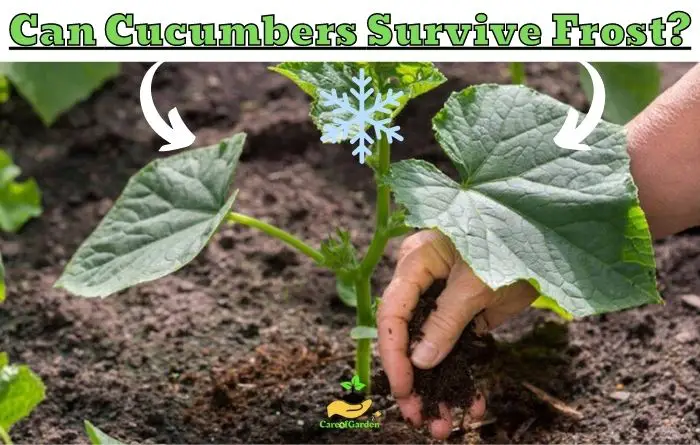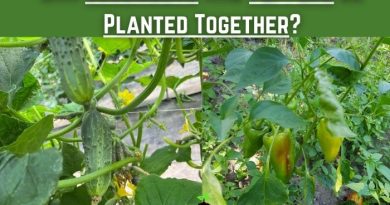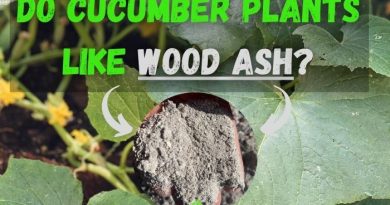Can Cucumbers Survive Frost? Easy Ways To Avoid Frost!
Cucumbers, with their refreshing taste and numerous culinary uses, are a popular addition to many gardens. However, one question that has often crossed my mind is whether cucumbers can survive the icy grip of frost.
In this blog post, we will explore whether cucumbers can withstand frost, discuss the hardiness of cucumber plants, and explore the factors that determine their ability to endure freezing temperatures. Additionally, we will provide practical tips on how to protect cucumber plants from frost, ensuring a successful and fruitful harvest.
Can Cucumbers Survive Frost?
Unfortunately, cucumbers cannot survive frost, whether they are grown indoors or outdoors. Cucumbers are generally considered to be warm-season plants, thriving in temperatures ranging from 70°F to 90°F (21°C to 32°C). Frost, which occurs when temperatures drop below the freezing point of water (32°F or 0°C), poses a significant risk to cucumber plants. Frost damage can cause wilting, browning, and tissue death in the leaves, stems, and fruits of cucumber plants, and can even render the fruits inedible.
However, it is important to note that cucumber plants are not frost-resistant. The effects of frost on cucumbers can vary depending on various factors, including the severity and duration of the frost, as well as the stage of growth the cucumber plants are in.
Signs and Consequences of Frost Damage on Cucumbers
| Signs of Frost Damage | Consequences of Frost Damage |
|---|---|
| Wilting and Drooping | Reduced Yield |
| Discolored Leaves | Delayed Harvest |
| Stunted Growth | Weakened Plants |
| Darkened Stems | Overall Plant Decline |
| Flower and Fruit Drop | Economic Loss |
Factors Affecting Cucumber’s Ability to Survive Frost
Several factors come into play when determining whether cucumbers can survive frost:
- Temperature: Cucumbers are susceptible to damage when exposed to freezing temperatures for an extended period. The severity and duration of the frost greatly influence the plants’ ability to survive.
- Plant Age: Young cucumber seedlings are more vulnerable to frost damage compared to mature plants. As plants mature, they tend to develop better tolerance to colder temperatures.
- Cultivar Selection: Choosing cold-tolerant cucumber varieties can significantly improve the chances of survival. When selecting cucumber seeds or seedlings, consider the hardiness rating and recommended planting zones provided by seed catalogs or local nurseries.
- Plant Health: Healthy cucumber plants are generally better equipped to endure adverse conditions, including frost. Proper nutrition, sufficient watering, and adequate pest management contribute to plant vigor and resilience.
The Hardiness of Cucumber Plants
Cucumber plants belong to the Cucurbitaceae family and exhibit varying degrees of hardiness. Some cucumber varieties are more cold-tolerant than others, allowing them to withstand colder temperatures and minor frost events.
For example, certain cultivars, such as “Siberian,” “Bush Slicer,” and “Northern Pickling,” are known for their ability to endure cooler conditions. These varieties are often recommended for gardeners in regions with shorter growing seasons or unpredictable weather patterns.
| Cucumber Variety | Cold Tolerance | Temperature Tolerance | Frost Tolerance |
|---|---|---|---|
| Marketmore 76 | Moderately cold tolerant | 50°F to 85°F (10°C to 29°C) | No |
| Northern Pickling | Cold tolerant | 45°F to 90°F (7°C to 32°C) | No |
| Siberian | Very cold tolerant | 40°F to 85°F (4°C to 29°C) | Yes |
| Cool Breeze | Cold tolerant | 50°F to 90°F (10°C to 32°C) | No |
| Bush Champion | Moderately cold tolerant | 50°F to 90°F (10°C to 32°C) | No |
| Armenian | Cold tolerant | 60°F to 95°F (15°C to 35°C) | No |
| Bushy | Cold tolerant | 50°F to 90°F (10°C to 32°C) | Yes |
| Green Slam | Cold tolerant | 55°F to 90°F (13°C to 32°C) | Yes |
| Suyo Long | Cold tolerant | 60°F to 95°F (15°C to 35°C) | No |
| Lemon | Cold tolerant | 60°F to 95°F (15°C to 35°C) | No |
| Diva | Cold tolerant | 55°F to 95°F (13°C to 35°C) | No |
How to Harden Cucumbers Seedlings

To avoid unpleasant consequences, it is advisable to harden the seedlings. Plants must be gradually accustomed to outdoor conditions: wind, ultraviolet radiation, sharp daily temperature fluctuations.
To do this, it is enough to put a tray with seedlings on the balcony for several hours. For heat-loving crops like cucumbers, this procedure is carried out when the temperature in the shade rises to 50°F (10°C).
Gradually increase the duration and intensity of exposure to sunlight and outdoor elements over the course of several days. Aim for a target of around 4 to 6 hours of direct sunlight per day by the end of the hardening off period.
If the daytime temperature exceeds 59°F (15°C), and the night temperature does not fall below 50°F (10°C), the seedlings can not be removed from the balcony. This will help the plants get used to the sudden spring temperature fluctuations.
How to Protect Cucumbers from Frost
When it comes to safeguarding your cucumber plants from the chilling effects of frost, there are several practical measures you can take. By implementing these protection strategies, you can shield your cucumbers and increase their chances of thriving despite cold weather.
- Covering: When frost is in the forecast, covering your cucumber plants can provide essential protection. Use blankets, old sheets, or frost cloth to create a physical barrier between the plants and the cold air. Ensure that the coverings reach the ground on all sides and secure them tightly to prevent cold air from seeping in. This simple technique can help trap heat radiating from the soil and create a warmer microclimate around the plants.
- Greenhouse or High Tunnel: If you have access to a greenhouse or high tunnel, consider transplanting your cucumbers into this protected environment. The controlled conditions inside a greenhouse offer excellent insulation against frost and allow for extended growing seasons. Cucumbers thrive in warm temperatures, and a greenhouse provides the ideal environment to ensure their growth and productivity.
- Mulching: Applying a layer of organic mulch around the base of cucumber plants is beneficial in multiple ways. Not only does it help retain soil moisture, but it also acts as an insulating barrier. A thick layer of straw or leaves acts like a cozy blanket, preventing rapid temperature fluctuations and protecting the plant’s root system. Mulch also helps suppress weed growth, which can compete with cucumbers for nutrients and water.
- Timing: Planting cucumbers after the danger of frost has passed is a straightforward way to avoid potential damage. Frost dates vary depending on your location, so it’s important to know the average last frost date in your area. Consult local gardening resources or online references to determine the optimal time for planting cucumbers in your region. By waiting until the frost risk has diminished, you give your cucumber plants a better chance to thrive.
- Watering: Proper watering practices can also play a role in protecting cucumbers from frost damage. Keep the soil consistently moist but not overly saturated. Well-hydrated plants are better equipped to withstand freezing temperatures. Watering in the morning allows the plants to absorb moisture before temperatures drop at night, reducing the risk of freezing.
- Cold-Tolerant Varieties: Consider planting cucumber varieties that are known for their cold tolerance. Some cultivars are specifically bred to withstand cooler temperatures and can handle minor frost events without significant damage. Research and choose cucumber varieties that are recommended for your climate and have a reputation for resilience in colder conditions. Check seed catalogs or consult with local nurseries for guidance on suitable cultivars.
Remember, while these methods can help protect your cucumber plants from frost, extreme or prolonged exposure to freezing temperatures may still cause damage.
Monitoring weather forecasts and being prepared to take additional protective measures, such as using portable heaters or constructing temporary cold frames, can further safeguard your plants during unexpected cold snaps.
How Long Can Cucumbers Survive Frost?
Based on my research, cucumber plants are not frost-tolerant and cannot survive frost, even for a few hours. When temperatures drop below 32°F (0°C), cucumber plants can be damaged or even killed. Young cucumber seedlings are more vulnerable and may not survive even a light frost.
What temperature is too cold for cucumbers?
Cucumber plants are generally sensitive to cold temperatures and thrive in warm climates. The lowest temperature that cucumber plants can tolerate without significant damage is around 50°F (10°C) according to Clemson University. However, they prefer temperatures between 70°F (21°C) and 90°F (32°C) for optimal growth and fruit production.
Exposure to temperatures below 50°F (10°C), especially for extended periods, can result in stunted growth, yellowing leaves, reduced fruit set, and even plant death. Therefore, it’s important to provide protection, such as covers or row tunnels, if you anticipate temperatures dropping below this threshold to ensure the health and productivity of your cucumber plants.
Can cucumbers survive frost indoors?
Based on my research and experience, cucumbers cannot survive frost regardless of whether they are indoors or outdoors. Whether you are growing cucumber indoors or outdoors they require warm temperatures. The optimal indoor temperature range of 70°F to 90°F (21°C to 32°C) is perfect for cucumber growth.




